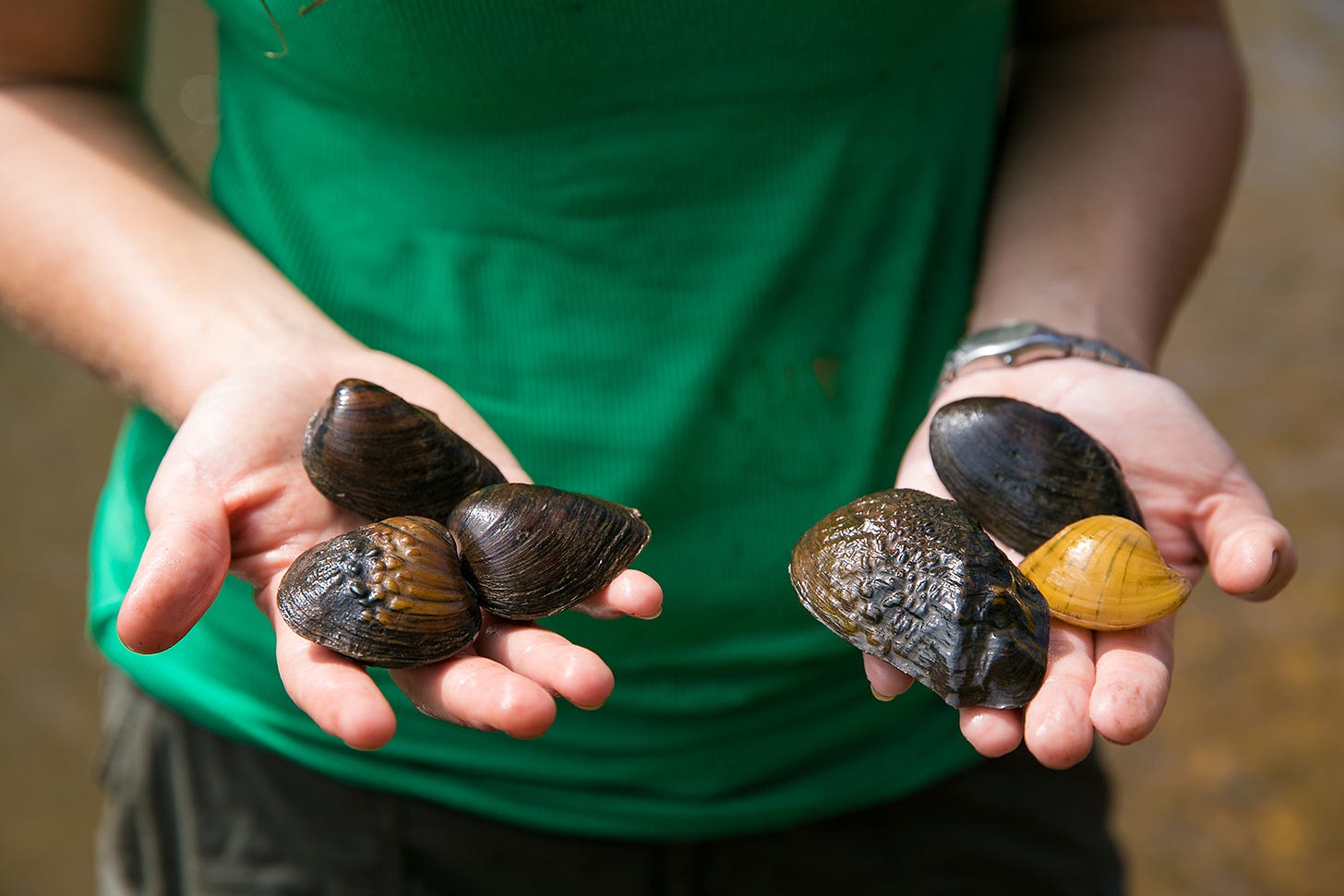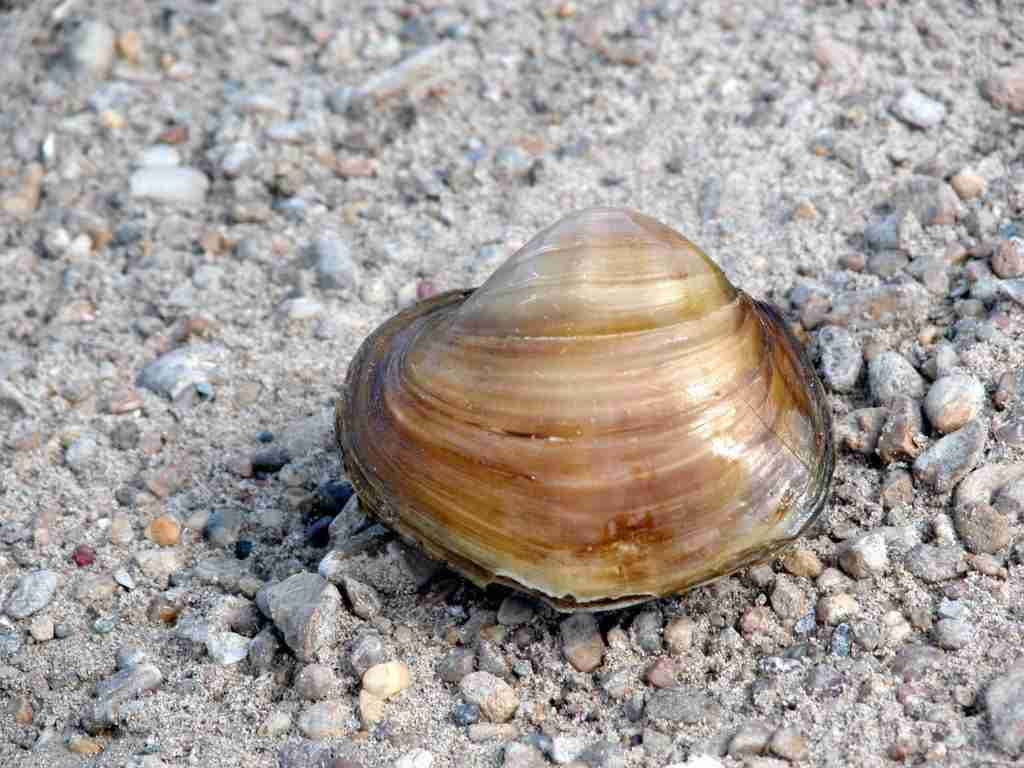
Mussels aren’t particularly charismatic. Crack open the shell and you’ll find a slippery lozenge of tissue that lacks anything resembling a brain. (Apparently mussels feel no pain.) The revelations of reproductive biology aren’t any more redeeming, either. The larvae of freshwater mussels, known as glochidia—a rather venereal-sounding name—are technically parasites, since unless they latch onto some suitable host fish, they will only survive a few days.
Let me give you an example of this process: when a female of one particular mussel species is ready to spawn, she extrudes a tail of flesh from her shell that looks something like a minnow. When a predator approaches to eat the false fish, the mussel spits out a glochidial cloud. Then the larvae’s tiny shells latch onto the fish’s gills and fins, where they become surrounded by fish tissue, encased in a cyst. The glochidia can live, buried within these cases of fish skin, for as long as a hundred days, feeding on tissue and blood plasma. One day, the cyst bursts open, and a juvenile bivalve floats to the river bottom to enjoy the rest of its rather quiet life.
Don’t let that squirm-inducing process color your overall opinion of mussels, though. These bivalves were once foundational to the nation’s riverine ecosystems—in the South especially. Wherever they grew, mussels filtered the water and provided structure for other creatures. Algae grow atop their beds. Insects ate the algae. Fish ate the insects—thereby completing a virtuous cycle whereby the supposed parasite helped its host survive. (Ecology, if not always appealing in its details, possesses an undeniable elegance.) Indeed, the importance of mussels is made clear by a strange inversion: Typically, as the writer Sharon Levy points out in Knowable, we protect habitat to save species. But there are efforts now to install mussels into threatened rivers to help revive their habitat.
Mussels are a particularly Southern treasure: More than 250 species of mussels live in this region. That’s roughly a quarter of all the mussel species in the world, and more than 90% of the mussel species in North America. This is a rare case where Alabama is a superlative: the most mussel-diverse state in the world’s most mussel-diverse country. The state features plains and ridges and mountains, an abundance of topography driving varied evolutionary stories, and, perhaps more importantly, several large rivers that have run through their different paths, fully disconnected, for millions of years. Consider Muscle Shoals, a name that is actually meant to be mussel shoals: here, more than seventy species of mussels once all but covered the bed of the Tennessee River for a twelve-mile stretch.
Note that so much of what I’ve written above is in the past tense. These little helpers are some of the most threatened critters on earth. The vast majority of the surviving mussel species in North America—which by necessity means the vast majority of the mussel species in the South—are considered under threat. The U.S. Fish and Wildlife Service delisted 21 species in October from the Endangered Species Act not because they had been saved but because the best science suggests they are gone from this planet. More than a third of the missing species were Southern mussels.
At Muscle Shoals, there are ancient middens twenty feet tall, extending for miles along the banks—evidence of the long human use of this bivalve. White settlers, though, found mussels too bland and chewy to be worth eating. So they ignored the creatures, at least until 1857, when a pearl found in a New Jersey mussel kicked off a national craze that lasted for decades. Some days in 1897, five hundred people could be found pearling a single sandbar on the Black River, which flows through Missouri and Arkansas. Local farmers hated the pearl boom, because it meant they could no longer find anyone to hire as fieldhands.
The destruction of American mussels may have been worst on the Upper Mississippi, where eventually the pearl-hunting furor was combined with a steadier economy of pearl button production: little circles were pressed out from the shells, to be affixed onto shirts. To provide the raw material, “clammers” worked from houseboats, wiping clear whole beds of mussels in a matter of months before picking up and finding somewhere else to attack.

As bad as the harvesting was, engineering is perhaps worse. Mussels want shallow, flowing water—and the dams we’ve built in rivers create instead deep, dark pools. This is what doomed the eponymous mussels of Muscle Shoals, for example. (River channelization and farm runoff are also major threats to mussels.)
There are efforts afoot to save mussels—“heroic” work, to quote Scientific American, though based less on the intellectual challenge than simply the tediousness involved. Generally, each mussel’s glochidia infect one and only one species of fish, and matching fish and mussel is a trial-and-error process.
I’m not sure that just conservation will be enough, though. These creatures need a reputation boost. And despite my ugly intro, I have to admit, the shells are beautiful. The names are great. In Alabama alone, you’ll find butterfly mussels and pigtoes and wartybacks and pistolgrips.1
Bird hunting gave way to birdwatching. Perhaps we need to resuscitate the old “clammer” tradition—but rather than ripping out the mussels, we should just see what mussels we’re able to track down.
So go grab your copy of Freshwater Mussels and dive in.
Want to see them?
The area around Muscle Shoals remains a hotspot, apparently. Also try the Clinch and Duck rivers in Tennessee, the Paint Rock River in northeast Alabama, and a short reach of the Bear Creek system in northwest Alabama and northeast Mississippi.
around the Southlands
🐟 Sure, Thanksgiving has passed, but I loved this essay by my friend Brett Martin, about an Alabama “fishgiving” tradition, enough to share it belatedly. (Garden & Gun)
🐾 Former enemies, the panther and the rancher, now face a common enemy in Florida: development. Saving the panther could be the way to save a rural way of life. (National Geographic)
+ See also my last newsletter, on conservation easements in Florida.
🛶 We all know the name of the Mississippi River. But few of us love the river enough. (Milwaukee Journal-Sentinal)
🪵 Enviva, a widely reviled company that cuts down Southern forests to produce a dubiously green energy product, finds itself on the financial ropes. (Inside Climate News)
🚜 With a controversial U.N. climate meeting underway, a very Southern industry has become a focus: agriculture. (Food Fix)
🍑 An official report concludes that forming a new national park in Georgia is a good idea, for cultural and environmental reasons, but suggests the price of buying the land is too high. (WMAZ)
🚤 The rise and fall of the Oklahoma town that was “created by Airbnb” (New York Times)
bonus: beyond the Southlands
🌿 One cure for a plague of loneliness? Spend more time in nature. But since there’s a plague of “biophobia,” too, too few people are willing to take the plunge. (The Atlantic)
Quick links
A rock quarry proposed near Alabama’s highest peak.
Worries over “the Batture.”
A master plan for Lincoln Beach.
Stemming the tide of foreign seafood.
How Kentucky’s high-tech farming start-up went awry.
A million gallons of oil in the Gulf.
🧑🏭️ Support Southlands: This newsletter is a labor of love, mostly. But your support, through a subscription, helps keep the newsletter alive. Not ready to pay yet? Another great way to support the cause is to pass this newsletter along to friends.
The pistolgrip is, apparently, the most important commercial species in the state that is now the leader of commercial musseling: exported for the use in pearl culturing, Alabama’s mussel harvest is worth some $20 million a year.




